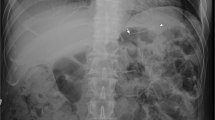Abstract
A 50-year old man, who has a history of allergies to IV contrast and NSAID, was presented with right renal colic. He was treated with regular opiate injections. Plain abdominal X ray showed a 1cm opacity at the level of L2 but spiral CT failed to locate the urinary calculus. Abdominal examination revealed a small piece of metal implanted in the subcutaneous anterior abdominal wall which was also subsequently identified on CT scanning. When the opiate treatment was withdrawn, the patient absconded.
Similar content being viewed by others
References
Reich JD, Hanno PM. Factitious renal colic. Urology 1997; 50(6): 858–862.
Mendelson RM, Arnold-Reed DE, Kuan M, Wedderburn AW, Anderson JE, Sweetman G, Bulsara MK, Mander J. Renal colic: a prospective evaluation of non-enhanced spiral CT versus intravenous pyelography. Aust Radiol 2003; 47(1): 22–28.
Meagher T, Sukumar VP, Collingwood J, Crawley T, Schofield D, Henson J, Lakin K, Connolly D, Giles J. Low dose computed tomography in suspected acute renal colic. Clin Radiol 2001; 56(11): 873–876.
Author information
Authors and Affiliations
Rights and permissions
About this article
Cite this article
Attar, K., Lee, G., Rowe, E. et al. The secret of the phantom stone: A case report. Int Urol Nephrol 36, 27–28 (2003). https://doi.org/10.1023/B:UROL.0000032684.22817.2f
Issue Date:
DOI: https://doi.org/10.1023/B:UROL.0000032684.22817.2f




